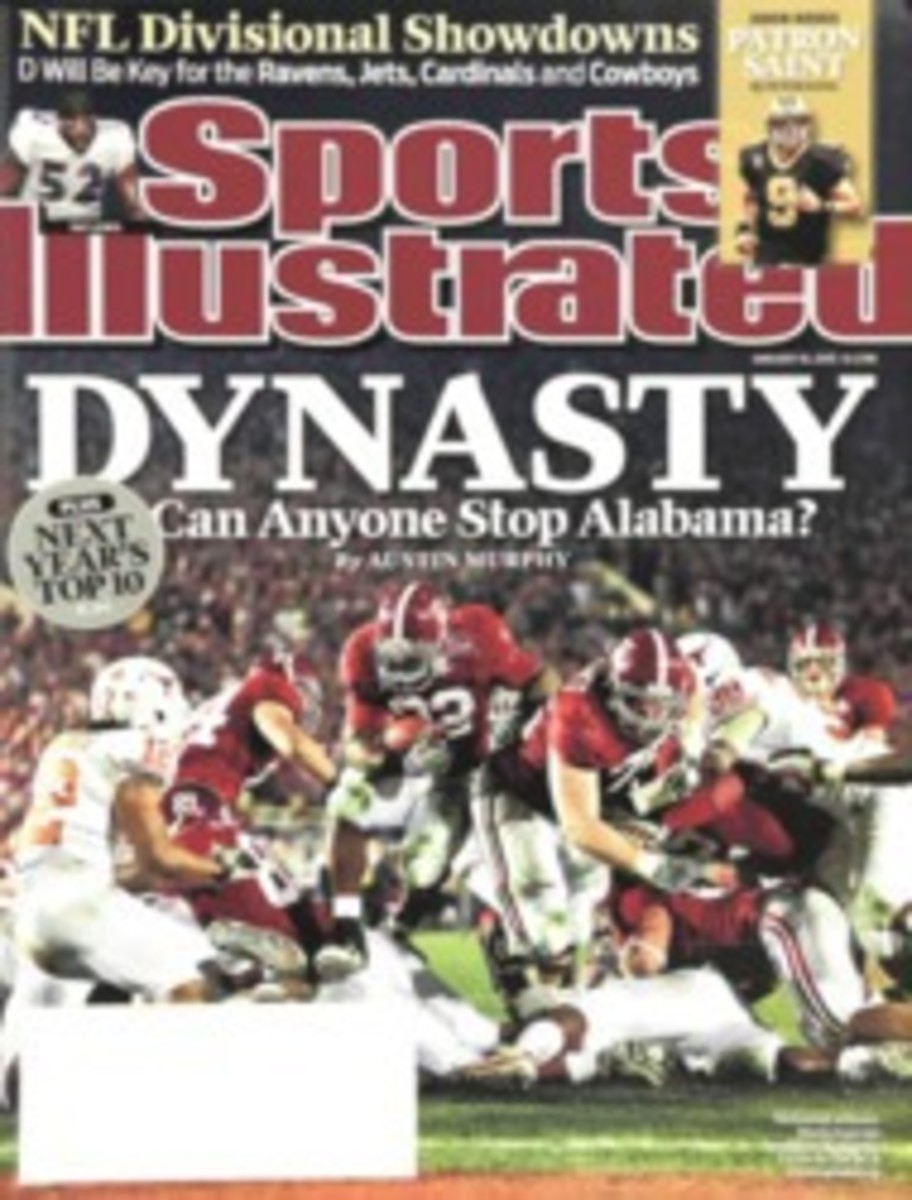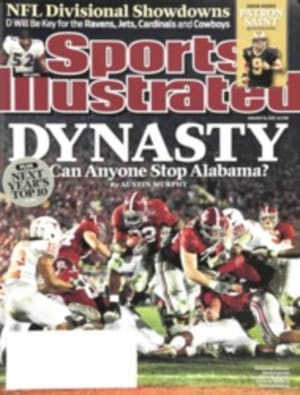
The Heart Of New Orleans
He's been the NFL's most prolific quarterback over the past four years, but to the city that has adopted him, Drew Brees is much more—a driving force in the ongoing effort to rebuild and renew
Last Thursday night, in a private upstairs room at Commander's Palace, the landmark New Orleans restaurant, Drew Brees convened what he calls his "secret society." In the dining room were seven of the city's richest men and biggest boosters, power players who have anonymously teamed with Brees for such post-Katrina causes as the refurbishment of Tad Gormley Stadium in City Park and the funding of the New Orleans Ballet Association's flagging after-school program. Brees calls the group (two of the members were absent that night) the Quarterback Club. As a token of thanks for contributions past—each man gave at least $25,000 in 2009—and future, Brees dispensed black-and-gold cuff links engraved with QB.
"I'd like to propose a toast," he said, lifting his champagne flute. "All of you care so deeply about the future of this city, not just from a business perspective but from a philanthropic perspective, and it's so desperately needed right now. A toast to you, and to New Orleans!"
"Hear, hear! To New Orleans!" the group responded.
Earlier in the Saints' bye week, their quarterback had spent two hours working on another of his pet projects, the Lusher Charter School, for which he'd help raise the money to build a new football field, weight room, scoreboard and running track after the September 2005 hurricane had devastated the facilities and the surrounding Uptown neighborhood. Now, nine days before New Orleans's playoff opener against the Cardinals in the Superdome, Brees chatted up and rubbed elbows with the men he knew could help him do real good for the city.
"Some guys might be playing 10 hours of Madden today, which is cool," Brees said as he took his seat after his toast. "But this is my outlet. This is what I love to do."
History can turn on the cruelest of events. Four years ago Brees, then with the Chargers, was playing against Denver in San Diego's season finale, a game that meant little because the Chargers had failed to make the playoffs. Brees, who'd been franchised by San Diego in 2005, was set to become a free agent when the final whistle blew. In the second quarter there was a loose ball. Brees dived for it, as did Broncos defensive tackle Gerald Warren. In the scrum Brees's right shoulder was dislocated, and the resulting damage—a total tear of his labrum and a partial tear of the rotator cuff—made the Chargers' off-season decision an easy one: They would let Brees walk, and Philip Rivers would become the starting quarterback.
Two teams were interested in Brees. The Dolphins were energized after going 9--7 in coach Nick Saban's rookie season. The Saints were in the dumps after going 3--13 and were unsure of their future after Katrina had ripped apart their city and left the Superdome an unplayable wreck. But Miami ultimately didn't trust that Brees's shoulder would heal in time for him to start the 2006 season, while first-year New Orleans coach Sean Payton loved Brees's leadership, accuracy, smarts and moxie so much that he didn't care.
"When I visited New Orleans," Brees said last week, "I saw it all, the good and the bad. The city was devastated. Brittany [Drew's wife] and I saw the Lower Ninth Ward. Unbelievable. Cars lying on top of houses. Boats through living-room windows. I felt like I was driving through a World War II documentary. But I just thought, This is a chance to be part of something incredible—the rebuilding of an American city. I felt like it was a calling. Like I was destined to be here."
Imagine the difference—for football, for New Orleans—if Saban had ignored the medical prognosis. He would have had Brees, not Daunte Culpepper, at quarterback, and he might have stayed with the Dolphins rather than bolting for Alabama. Quite possibly the Crimson Tide wouldn't have been hoisting the national championship trophy last week. And the Saints might well be playing in San Antonio or Los Angeles instead of packing the refurbished Superdome for a playoff game, with a new lease at the stadium through 2025.
"I can't even think about that," says Owen Brennan, executive director of the Krewe of Bacchus, which runs the most storied Mardi Gras parade. Brees has been appointed the King of Bacchus for the 2010 edition, the first athlete so honored. "It's a nightmare. Don't even say it. Ooooo. What he's done for this city is absolutely immeasurable."
On the measurable side the Brees Dream Foundation has raised $1.85 million for its Rebuilding Dreams campaign. Some of the money goes to Katrina-related causes, such as athletic-field reconstruction. Some of it goes to needs that would otherwise not be addressed because so much funding has been diverted to hurricane relief. The latter projects include a home for families of cancer patients, and the Samuel J. Green Charter School's "edible schoolyard," in which students grow food on campus while studying nutrition and agricultural science. The produce they grow ends up on the school menu.
One of Brees's favorite causes is the Lusher School, a battered 76-year-old facility four miles southwest of the French Quarter. Like the Superdome, Lusher was damaged by wind and water, and it served as a shelter for those made homeless by the storm. Some lived for weeks in the school, which might never have reopened if not for the ambitious efforts of New Orleans educators. "Drew realized that nothing breathes life into a city neighborhood like kids playing," says Lusher CEO Kathy Hurstell-Riedlinger as she conducts a tour of the school and its grounds. "We had to rebuild the field, which was dangerous, and show the community that this school was here to stay."
Brees's foundation and two corporate sponsors donated $671,000. In New Orleans, where more than four years after Katrina so much remains to be done, it's a measure of progress that the once-ravaged Lusher looks for the most part like any average American school. BREES FAMILY FIELD, as the scoreboard in one end zone reads, would be the envy of many athletic programs.
"Before, it was a death trap out here," says senior Pierce Wisdom during a break in soccer practice. "I remember wondering if I made the right decision to come back to school here instead of going somewhere with better facilities. We all appreciate what Drew did so much."
Brees knew that to be competitive, Lusher's football program would also need a weight room. Drew and Brittany picked up the $38,000 tab for that (with some big price breaks from fitness-equipment manufacturers). Last week, while walking through the school, Brees stopped into the 15-by-40-foot weight room as some football players were lifting. When he saw junior linebacker Jeremy Bailey using the wrong technique on squats, Brees, dressed in business clothes and dress shoes, showed him the proper method—sitting straight down, not leaning forward. "Think about tightening your core," Brees said as he shouldered the bar and did a squat. "Technique. Always remember technique."
"He's like an uncle who donates a lot of toys," said junior noseguard Caleb Windsay. "The field and the weight room give us a chance to compete. It's an incredible thing for him to do for us."
As Brees left the room, one of the kids yelled out, "Win the Super Bowl!"
"One game at a time," Brees said over his shoulder. "One game at a time."
That philosophy has served Brees well since he signed a six-year, $60 million contract with the Saints. Over the last four seasons no quarterback has thrown for more yards than Brees (18,298), and only one has as many touchdowns. (He and Peyton Manning both have 122.) In 2009 Brees set an NFL record for accuracy—his 70.62% besting Ken Anderson's 27-year-old mark by .07%.
It's not just pinpoint passing that has made Brees such a good match for Payton's offense—the NFL's short-passing culture has spawned a slew of dink-and-dunk chain movers. In a 38--17 statement-game thrashing of the Patriots on Nov. 30, Brees threw three long downfield passes, each on a dime. "An amazing display," Payton calls it. "To throw it that deep that accurately is something that sets Drew apart from every quarterback out there."
When New Orleans takes the field on Saturday night against the Cardinals, however, Brees won't be concerned with those numbers. By then it will have been seven weeks since the Saints played like the best team in the NFC. After winning 13 in a row, the highest-scoring club in the league lost its last three games, putting up just 17 points each in a Week 15 loss to the Cowboys and a Week 16 defeat to the Buccaneers, then resting Brees and many other starters in a 23--10 loss at Carolina. For the Saints to fulfill the wishes of those Lusher kids and the rest of the city, Brees will have to awaken the dormant offense and hope the pass blocking is significantly better than it was when Dallas linebackers DeMarcus Ware and Anthony Spencer used Brees as a tackling dummy.
The Saints are convinced that by tweaking some protections, they can keep Brees clean and rewire the slumping offense. The tricky part will be combining the varied looks of Payton's schemes that keep defenses off-balance with more secure blocking. Expect the Saints to keep a tight end or back in more than usual to help keep Brees clean, especially if they face the blitz-heavy Vikings or Cowboys in the conference championship game. And look for speedy deep threat Robert Meachem to catch Brees's eye more often.
"All the time since we've played a good all-around game, it sort of feels like going into a bowl game in college," Brees said. "It's been a while. But I feel like the more you win, the harder it gets. You go 11--0, 12--0, 13--0, and the teams you play treat it like the biggest game of the year. We felt that down the stretch. I can confidently say we can fix the things that got us beat, because I know this offense so well. I can tell you I'm not worried."
In a town that once worried about so much, including keeping its NFL team, that message should calm a nervous fan base. Especially when it comes from an athlete as adored and appreciated as any in an American city today.
Now on SI.com
Complete playoff coverage from Peter King and the SI crew at SI.com/NFL
"I felt like it was a calling," Brees says of his move, "like I was destined to be here."
"Win the Super Bowl!" one one of the schoolkids yelled out. "One game at a time," Brees said over his shoulder.
PHOTO
Photograph by BOB ROSATO
FATE AND FOOTBALL A series of chance events brought Brees to town—and his arrival helped keep the Saints from leaving.
THREE PHOTOS
MICHAEL J. LEBRECHT II/1DEUCE3 PHOTOGRAPHY
PATRON SAINTS Drew and Brittany (right, with son Baylen) contributed to the refurbishing of the Lusher School's renamed football field, just one of many post-Katrina projects for which they've raised funds.
PHOTO
DAVID E. KLUTHO
ZEROING IN After the most accurate single season in NFL history, Brees has his sights on New Orleans's first title.
PHOTO
SEAN GARDNER/REUTERS
[See caption above]

